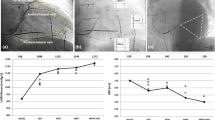Summary
In DDD pacing, the left-ventricular electromechanical latency period defines the duration between premature ventricular stimulation and the prematurely ending left-atrial contribution to left-ventricular filling. It has to be considered in diastolic AV delay optimization. Individual duration of this parameter seemed to reflect the ventricular function. Therefore, we compared the left-ventricular electromechanical latency period due to right ventricular stimulus with the documented ejection fraction of two groups, 33 congestive heart failure patients carrying biventricular systems and 13 right ventricular paced bradycardia patients. A mean latency period of 168±26 ms was found in the heart failure patients (ejection fraction: 25±5%) which was significantly longer (p=0.0039) compared to the bradycardia patients (ejection fraction: 51±12%) with a mean latency of 119±13 ms. Thus, an increasing latency period during right ventricular DDD pacing therapy indicates decreasing ejection fraction. A cut-off interval of 135 ms allowed the discrimination of 93% of our patients as having an individual ejection fraction of either up to 35% or above. Thus, the left ventricular electromechanical latency period can be used as an additional parameter indicating the neccesity to upgrade from right to biventricular DDD pacing.
Zusammenfassung
Die linksventrikuläre elektromechanische Latenzzeit beschreibt bei DDD-Stimulation die zeitliche Relation zwischen einem verfrüht abgegebenen ventrikulären Stimulus und dem folglich vorgezogenen Ende des linksatrialen Betrages zur linksventrikulären Füllung. Ihre Dauer wird bei einer diastolischen Optimierung der AV-Intervalle berücksichtigt. Individuelle Messungen deuteten auf eine Abhängigkeit von der linksventrikulären Funktion hin. Wir verglichen darum bei 33 wegen chronischer Herzinsuffizienz biventrikulär und 13 antibradykard rechtsventrikulär AV-sequenziell stimulierten Patienten die auf rechtsventrikuläre Stimuli bezogenen linksventrikuläre elektromechanische Latenzzeit mit der dokumentierten linksventrikulären Ejektionsfraktion. Im Ergebnis fand sich bei den Herzinsuffizienten (mittlere Ejektionsfraktion: 25±5%) eine mittlere Latenzzeit von 168±26 ms. Sie war signifikant länger (p<0,0039) als bei den antibradykard stimulierten Patienten mit im Mittel 119±13 ms (mittlere Ejektionsfraktion: 51±12%). Im Verlaufe einer Therapie mit konventionellen DDD-Systemen deutet somit eine Verlängerung der linksventrikulären elektromechanischen Latenzzeit auf eine Verminderung der Ejektionsfraktion. Der von uns gefundene Grenzwert von 135 ms erlaubte bei 93% der untersuchten Patienten die richtige Zuordnung zu individuellen Ejektionsfraktionen bis zu 35% bzw. darüber. Sein Überschreiten kann als zusätzlicher Indikator die Notwendigkeit eines Upgradings von rechts- auf biventrikuläre DDD-Stimulation untermauern.
Similar content being viewed by others
Literatur
Brecker SJ, Xiao HB, Sparrow J, Gibson DG (1992) Effects of dual-chamber pacing with short atrioventricular delay in dilated cardiomyopathy. Lancet 340:1308–1312
Bruch C, Schmermund A, Martin D et al (2005) Tei-index in patients with mild to moderate congestive heart failure. Eur Heart J 21:1888–1895
Gold MR, Feliciano Z, Gottlieb SS, Fisher ML (1995) Dual-chamber pacing with a short atrioventricular delay in congestive heart failure: a randomized study. J Am Coll Cardiol 26:967–973
Ishikawa T, Sumita S, Kimura K et al (1999) Prediction of optimal atrioventricular delay in patients with implanted DDD pacemakers. Pacing Clin Electrophysiol 20:1365–1371
Ismer B, von Knorre GH, Voss W et al (2002) Definition of the optimal atrioventricular delay by simultaneous measurement of electrocardiographic and Doppler-echocardiographic parameters. Prog Biomed Res 7:116–120
Lind L, Andren B, Arnlov J (2005) The doppler derived myocardial performance index is determined by both left ventricular systolic and diastolic function as well as by afterload and left ventricular mass. Echocardiography 22:211–216
Ritter P, Dib JC, Mahaux V et al (1995) New method for determining the optimal atrio-ventricular delay in patients paced in DDD mode for complete atrio-ventricular block (abstract). Pacing Clin Electrophysiol 18:855
Ritter P, Padeletti L, Gillio-Meina L, Gaggini G (1999) Determination of the optimal atrioventricular delay in DDD pacing. Comparison between echo and peak endocardial acceleration measurements. Europace 1:126–130
Tei C, Ling LH, Hodge DO et al (1995) New index of combined systolic and diastolic myocardial performance: a simple and reproducible measure of cardiac function—a study in normals and dilated cardiomyopathy. J Cardiol 26:357–366
Author information
Authors and Affiliations
Corresponding author
Rights and permissions
About this article
Cite this article
Ismer, B., Körber, T., von Knorre, G.H. et al. Die linksventrikuläre elektromechanische Latenzzeit ist ein zusätzlicher Indikator für ein Upgrading zur biventrikulären Stimulation. Herzschr. Elektrophys. 17 (Suppl 1), i37–i41 (2006). https://doi.org/10.1007/s00399-006-1106-8
Issue Date:
DOI: https://doi.org/10.1007/s00399-006-1106-8




